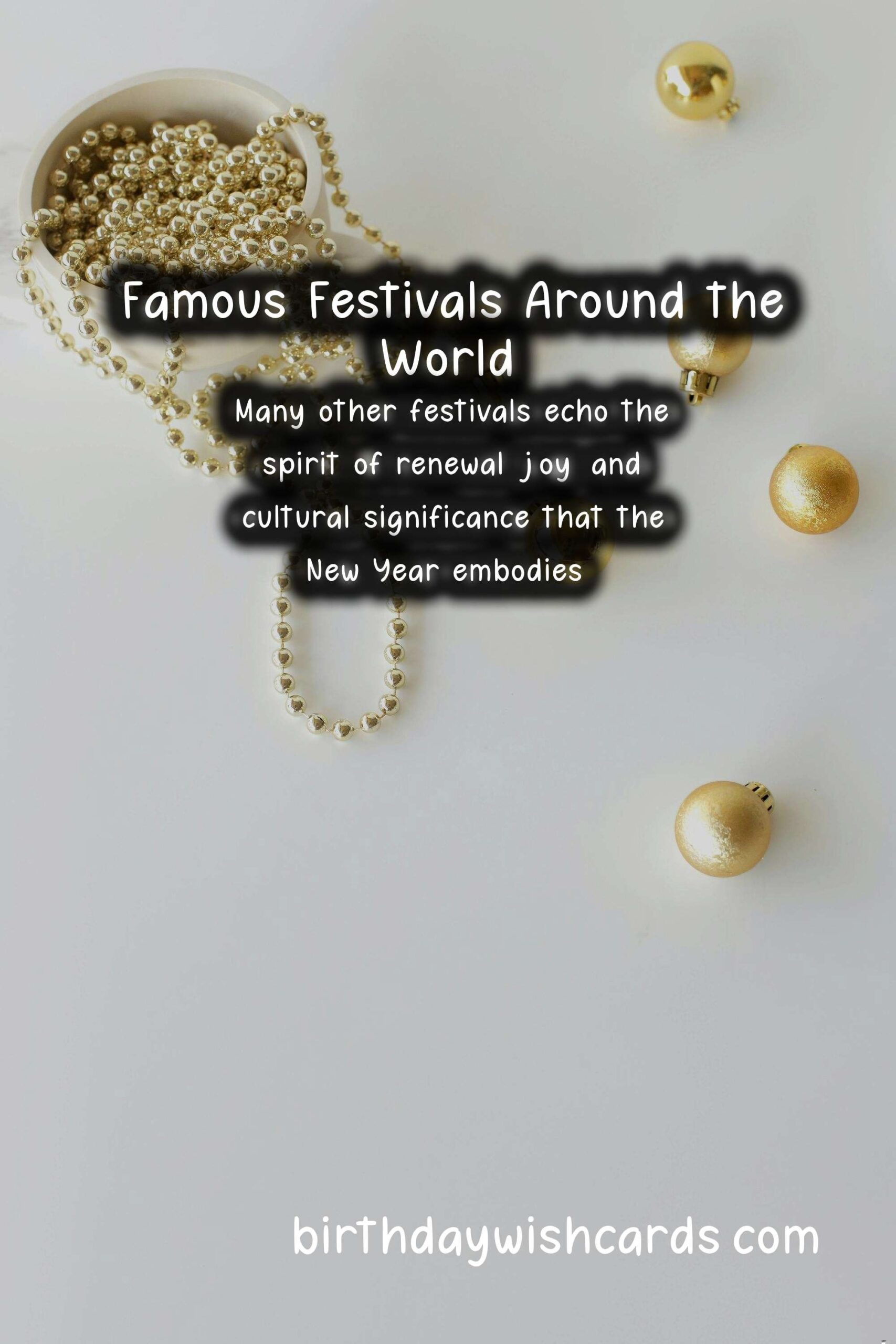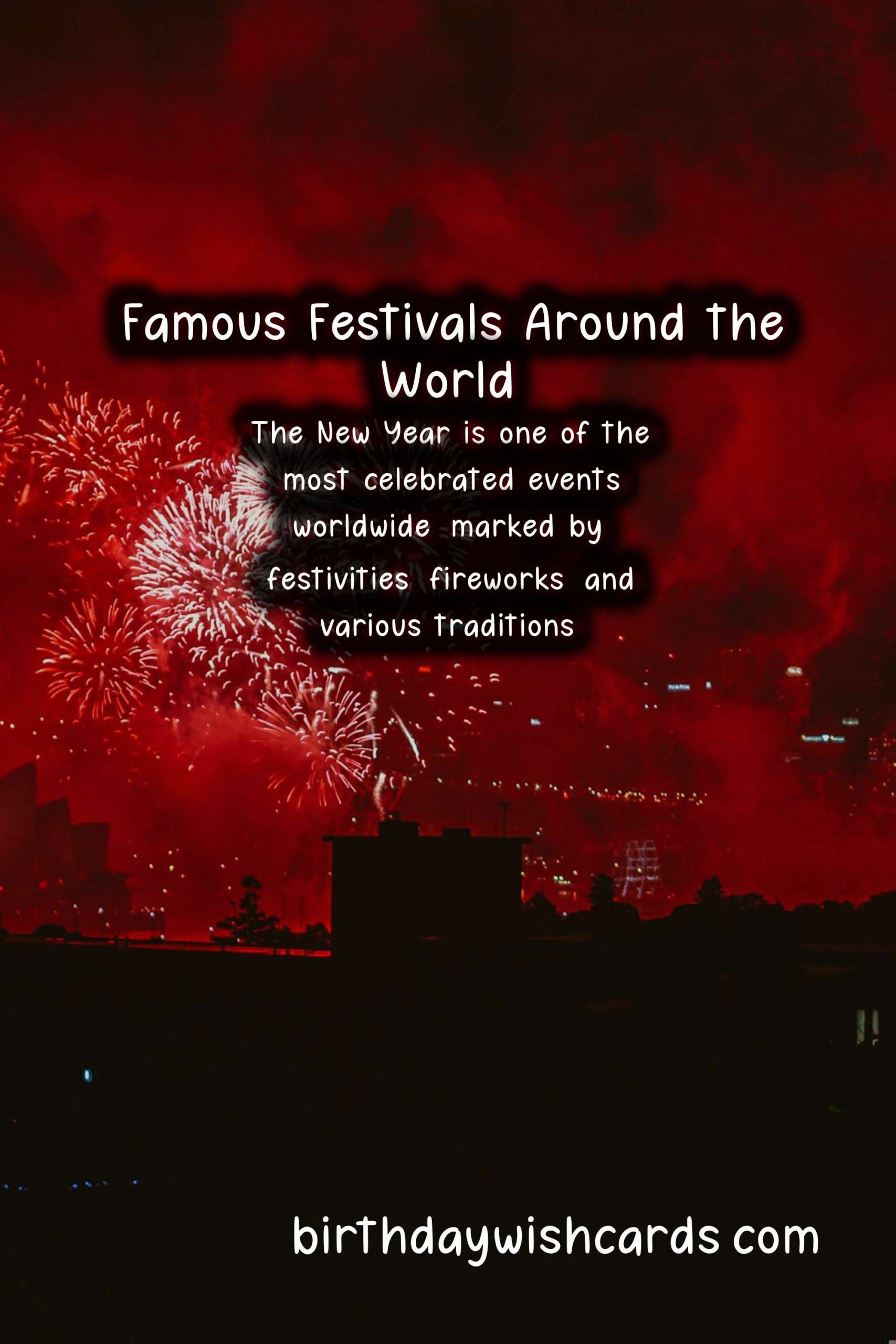Exploring Famous Festivals Around the World Similar to New Year Celebrations
Exploring Famous Festivals Around the World Similar to New Year Celebrations
The New Year is one of the most celebrated events worldwide, marked by festivities, fireworks, and various traditions. However, many other festivals echo the spirit of renewal, joy, and cultural significance that the New Year embodies. In this article, we will explore some of these famous festivals, their origins, customs, and how they reflect the essence of new beginnings.
1. Chinese New Year
The Chinese New Year, also known as the Lunar New Year or Spring Festival, is celebrated by millions of people around the world. This festival marks the beginning of the lunar calendar and typically falls between January 21 and February 20.
Traditions during Chinese New Year include family reunions, elaborate feasts, giving red envelopes (hongbao) with money, and decorating homes with red lanterns and banners. The celebrations last for 15 days, culminating in the Lantern Festival, where people release lanterns into the sky, symbolizing the release of the past year’s troubles.
2. Diwali
Diwali, often referred to as the Festival of Lights, is one of the most important Hindu festivals celebrated primarily in India and by Indian communities worldwide. It usually falls between mid-October and mid-November.
The festival signifies the victory of light over darkness and good over evil. Celebrations include lighting oil lamps (diyas), decorating homes, exchanging gifts, and fireworks displays. Families come together to pray, celebrate, and share meals, embodying unity and the spirit of renewal.
3. Nowruz
Nowruz, meaning ‘new day,’ marks the Persian New Year and the arrival of spring. Celebrated on the vernal equinox, it usually occurs around March 20 or 21. This festival has roots in Zoroastrianism and is celebrated by millions in Iran and other parts of Central Asia, the Middle East, and the Caucasus.
Customs include cleaning and decorating homes, visiting family and friends, and preparing a special feast. The Haft-Seen table, an arrangement of seven symbolic items, is a central feature of the celebration, representing health, prosperity, and renewal.
4. Rosh Hashanah
Rosh Hashanah, the Jewish New Year, typically falls in September and marks the beginning of the High Holy Days. It is a time for reflection, prayer, and renewal.
Customs include sounding the shofar (a ram’s horn), attending synagogue services, and sharing meals that feature symbolic foods such as honey and apples, representing sweetness and hope for the coming year.
5. Songkran
Songkran is the Thai New Year festival that takes place in April. This vibrant festival is widely known for its water fights and symbolizes the washing away of sins and bad luck.
During Songkran, people pour water over Buddha statues, visit temples, and engage in joyful water battles in the streets, celebrating the arrival of the new year with fun, laughter, and a sense of community.
6. Eid al-Fitr
Eid al-Fitr, also known as the Festival of Breaking the Fast, is celebrated by Muslims worldwide at the end of Ramadan, the holy month of fasting. The festival varies depending on the lunar calendar and is one of the most important Islamic celebrations.
Eid al-Fitr begins with a special prayer service, followed by festive meals, giving to charity (Zakat al-Fitr), and exchanging greetings. This festival encourages reflection, gratitude, and community togetherness, reflecting the essence of new beginnings.
7. Vesak
Vesak, or Buddha Day, is celebrated by Buddhists to commemorate the birth, enlightenment, and death of Gautama Buddha. It typically occurs in May, based on the lunar calendar.
During Vesak, devotees visit temples, offer alms to monks, and engage in acts of kindness. The festival emphasizes renewal and compassion, encouraging individuals to reflect on their lives and strive for spiritual growth.
8. Obon
Obon is a Japanese festival held to honor the spirits of ancestors. It takes place in mid-August and is considered a time for the living to remember and pay respect to their loved ones who have passed away.
Traditions include visiting graves, lighting lanterns, and performing traditional dances known as Bon Odori. The festival embodies a sense of gratitude, remembrance, and the connection between the living and the spirits, marking a time of renewal for family bonds.
9. Mid-Autumn Festival
The Mid-Autumn Festival, also known as the Moon Festival, is celebrated in various Asian cultures, notably in China and Vietnam. It takes place on the 15th day of the 8th lunar month and symbolizes the harvest and family reunion.
Customs include mooncake sharing, lantern displays, and family gatherings. The festival celebrates the beauty of the full moon and the abundance of harvest, reflecting themes of unity, gratitude, and renewal.
10. Midsummer
Midsummer is celebrated in various countries, particularly in Scandinavia, and aligns with the summer solstice in June. This festival symbolizes the peak of summer and is a time for celebrations of light and nature.
Traditions include bonfires, dancing around the maypole, and feasting. Midsummer embodies joy, community, and appreciation for nature’s abundance, a celebration akin to new beginnings in the cycle of seasons.
Conclusion
These festivals, much like New Year celebrations, embody themes of renewal, joy, and unity. They reflect diverse cultural traditions and highlight the universal desire for new beginnings and connections. Whether through vibrant parades, sacred rituals, or family gatherings, each festival offers a unique way to celebrate life and look forward to the future.
The New Year is one of the most celebrated events worldwide, marked by festivities, fireworks, and various traditions.
Many other festivals echo the spirit of renewal, joy, and cultural significance that the New Year embodies.









#NewYear #Festivals #Culture #Celebration #Traditions






